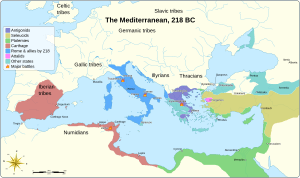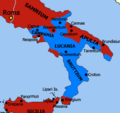Second Punic War facts for kids
Quick facts for kids Second Punic War |
|||||||||
|---|---|---|---|---|---|---|---|---|---|
| Part of the Punic Wars | |||||||||
|
The Mediterranean in 218 BC |
|||||||||
|
|||||||||
| Belligerents | |||||||||
Aetolian League Pergamon Numidia Iberian tribes Celtiberian tribes |
Ancient kingdoms of Liguria Syracuse Masaesyli Massylii Other Greek states Iberian tribes Celtiberian tribes |
||||||||
| Commanders and leaders | |||||||||
Syphax (POW) |
|||||||||
| Strength | |||||||||
|
768,500
|
Unknown | ||||||||
| Casualties and losses | |||||||||
| 500,000 dead (300,000 killed in action) 400 towns destroyed |
270,000 dead | ||||||||
| 770,000 dead | |||||||||
| The Romans enslaved 14 Italian and Sicilian towns and massacred the entire population of two other towns. | |||||||||
The Second Punic War was a huge conflict between Carthage and the Roman Republic. It lasted from 218 BC to 201 BC. This war is famous for its great generals, especially Hannibal from Carthage and Scipio Africanus from Rome. It was the second of three major wars between these two powerful states, known as the Punic Wars.
The war started because Carthage and Rome were rivals. They both wanted to control more land and trade routes around the Mediterranean Sea. The First Punic War had ended with Rome winning and Carthage losing some land and money. Hannibal, a Carthaginian general, wanted revenge for his city.
Contents
Why Did the Second Punic War Start?
The First Punic War ended in 241 BC. Carthage had to give up Sicily and pay a lot of money to Rome. Hannibal's father, Hamilcar Barca, made his son promise to always be an enemy of Rome. Hannibal grew up to be a brilliant military leader.
Hannibal's Bold Plan
Hannibal decided to attack Rome by surprise. Instead of sailing across the sea, he planned to march his army over the Alps mountains. This was a very difficult journey. He took thousands of soldiers, horses, and even elephants with him. Many men and animals died during the cold and dangerous trip.
The Siege of Saguntum
The war officially began when Hannibal attacked the city of Saguntum in Hispania (modern-day Spain). Saguntum was an ally of Rome. Rome saw this attack as a direct challenge. They demanded that Carthage hand over Hannibal. Carthage refused, and so the war began.
Hannibal's Invasion of Italy
After crossing the Alps, Hannibal's army arrived in northern Italy in 218 BC. The Romans were shocked. They did not expect an attack from that direction. Hannibal quickly won several battles against Roman armies.
Early Roman Defeats
- Battle of the Trebia (218 BC): Hannibal defeated a Roman army near the Trebia River. He used a clever trap, hiding some of his soldiers.
- Battle of Lake Trasimene (217 BC): Hannibal ambushed another Roman army by a lake. The Roman general, Gaius Flaminius, was killed, and many Roman soldiers died.
- Battle of Cannae (216 BC): This was one of the worst defeats in Roman history. Hannibal's smaller army completely surrounded and destroyed a much larger Roman force. Tens of thousands of Romans were killed.
Fabius Maximus: The Delayer
After these defeats, the Romans chose Fabius Maximus as their leader. He used a new strategy. Instead of fighting Hannibal directly, he avoided big battles. He followed Hannibal's army, cutting off their supplies and harassing them. This strategy was called "Fabian tactics." It was unpopular at first because it seemed cowardly, but it saved Rome from more big losses.
The War Spreads Out
While Hannibal was in Italy, the war was also fought in other places.
Fighting in Hispania
Rome sent armies to Hispania to stop Carthaginian supplies and reinforcements from reaching Hannibal. The Roman generals Publius Cornelius Scipio and his brother Gnaeus fought against Hannibal's brother, Hasdrubal Barca. The fighting was tough, and both Roman generals were killed in 211 BC.
Scipio Africanus Rises
After the deaths of his father and uncle, Scipio Africanus took command of the Roman forces in Hispania. He was very young but a brilliant strategist. He captured the main Carthaginian base in Hispania, Carthago Nova (modern-day Cartagena), in 209 BC. He then defeated Hasdrubal Barca in the Battle of Baecula in 208 BC.
Hasdrubal tried to march to Italy to help Hannibal, but he was defeated and killed by the Romans at the Battle of the Metaurus River in 207 BC. This was a huge blow to Hannibal, who was now truly alone in Italy.
War in Sicily and Africa
Rome also fought Carthage in Sicily and North Africa.
- Sicily: The city of Syracuse, a former Roman ally, joined Carthage. Rome besieged Syracuse for two years (214-212 BC) and eventually captured it.
- Africa: Scipio Africanus believed the best way to defeat Hannibal was to attack Carthage itself. He convinced the Roman Senate to let him invade North Africa.
The Final Showdown: Battle of Zama
In 204 BC, Scipio landed his army in North Africa. He won several victories against Carthaginian forces and their allies. Carthage was forced to call Hannibal back from Italy to defend their homeland.
Hannibal Returns Home
Hannibal had been in Italy for over 15 years. He had won many battles but had never been able to defeat Rome completely. Now, he had to leave Italy and return to Carthage.
The Battle of Zama (202 BC)
The final battle of the Second Punic War was fought at Zama in North Africa. Hannibal and Scipio faced each other. Scipio had learned from Hannibal's tactics. He used a clever strategy to deal with Hannibal's war elephants. The Roman and Numidian cavalry (horse soldiers) played a key role. Scipio's army decisively defeated Hannibal's forces.
What Happened After the War?
Carthage lost the Second Punic War. They had to agree to harsh peace terms with Rome.
- Carthage had to give up all its territories outside Africa.
- They had to pay a huge amount of money to Rome over many years.
- They were not allowed to have a large army or navy.
- They could not go to war without Rome's permission.
The Second Punic War made Rome the most powerful state in the western Mediterranean. It set the stage for Rome to become a huge empire. Hannibal, despite his genius, could not overcome Rome's determination and resources.
Images for kids
See also
 In Spanish: Segunda guerra púnica para niños
In Spanish: Segunda guerra púnica para niños










